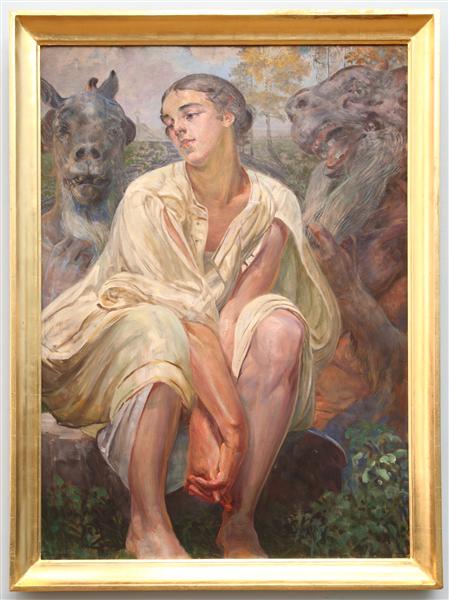Description
Jacek Malczewski's "slavery" painting, created in 1894, stands as a powerful representation of internal struggle and oppression, fundamental characteristics of the visual exchange of symbolist art. This work, which encapsulates the artist's concern for human suffering and freedom, is in the context of social and political tensions of the late nineteenth century in Poland. Malczewski, a central figure in the Polish symbolist movement, connected deeply with this theme, using his works as a vehicle to explore the pain and yearning of the human condition.
In the heart of "slavery" there is a composition that displays intense visual complexity, marked by the interaction between human figures and their surroundings. The foreground is dominated by the figure of a woman, who with an expression of deep suffering and resignation, seems to represent the essence of oppression. His face, delineated with an almost ethereal touch, reflects a liberation desire, a desire that resonates in the viewer. This figure is surrounded by a landscape that highlights its vulnerability: a gloomy and desolate background accentuates the contrast to its presence, suggesting an atmosphere of hopelessness.
The use of color in this work further reinforces symbolic narrative. The gloomy tones, such as gray and dark, evoke a sense of melancholy and anguish, while the clearest nuances in the woman's locker room provide a halo of fragility and purity in their image. Through this palette, Malczewski not only transmits visualizing the issue of slavery, but also evokes an emotional state in the viewer. The shadows that surround it, conjure environments of misunderstanding and restrictive limitations, reflecting the internal struggle of the individual in the face of social and political oppression.
Malczewski is also connected to a broad spectrum of artistic influences, from Belgian symbolism to the art of romantic painting. The inevitability of the human experience and the introspection it presents, exalt their work and place it in a permanent dialogue with other artists of their time, as well as with later currents. Although his work can be considered in part as a reflection of Polish reality, his symbolism appeals to the broader universes of human experience, which allows "slavery to resonate with all those who have felt trapped or repressed.
Similarly, it can be seen that Malczewski's style, impregnated with a mixture of symbolism, mysticism and a strong emotional content, manifests itself in other of his works, where themes such as identity, suffering and personal transformation are also confronted. paintings as "the death of Proserpina" and "the vision of death" exhibit the same ability to capture human pain through a personal and deep perspective, even turning the tragedy into a form of beauty.
In "Slavery", Jacek Malczewski presents a work that is both a portrait of oppression and a meditation on the struggle for freedom. Through its powerful iconography, careful composition and the symbolic use of color, it manages to invoke a deep sense of empathy in the viewer, turning this painting into a enduring testimony of human desire for freedom and dignity. Ultimately, "slavery" not only confronts us with the dark legacy of oppression, but also invites us to reflect on the deepest meaning of liberation in our own lives.
KUADROS ©, a famous paint on your wall.
Hand-made oil painting reproductions, with the quality of professional artists and the distinctive seal of KUADROS ©.
Art reproduction service with satisfaction guarantee. If you are not completely satisfied with the replica of your painting, we refund your money 100%.

